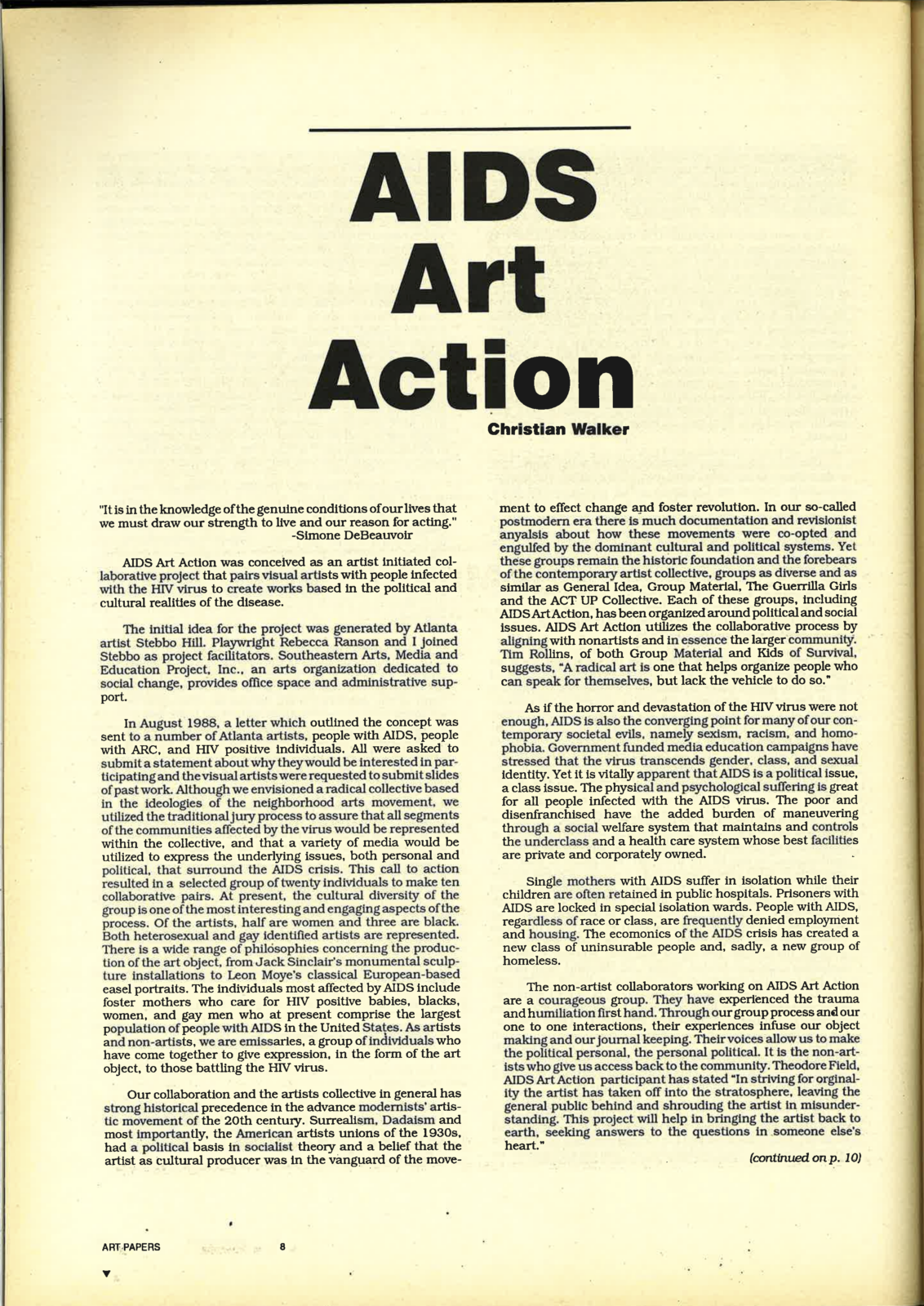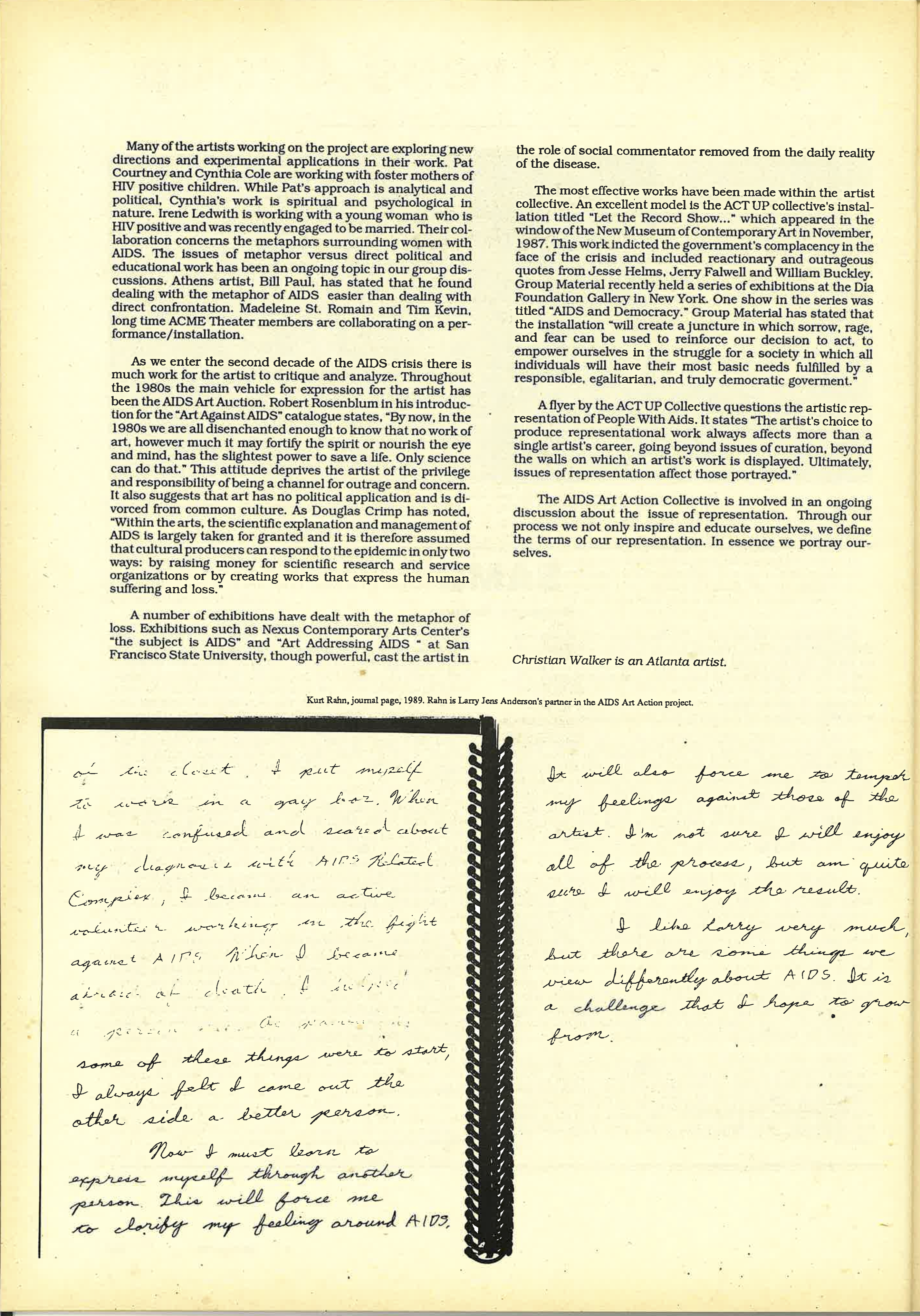AIDS Art Action
Share:
This feature was originally published in ART PAPERS March /April 1989, Vol. 13, issue 2.
“It is in the knowledge of the genuine conditions of our lives that we must draw our strength to live and our reason for acting”
– Simone DeBeauvoir
AIDS Art Action was conceived as an artist initiated collaborative project that pairs visual artists with people infected with the HIV virus to create works based in the political and cultural realities of the disease.
The initial idea for the project was generated by Atlanta artist Stebbo Hill. Playwright Rebecca Ranson and I joined Stebbo as project facilitators. Southeastern Arts, Media and Education Project, Inc., an arts organization dedicated to social change, provides office space and administrative support.
In August 1988, a letter which outlined the concept was sent to a number of Atlanta artists, people with AIDS, people with ARC, and HIV positive individuals. All were asked to submit a statement about why they would be interested in participating and the visual artists were requested to submit slides of past work. Although we envisioned a radical collective based in the ideologies of the neighborhood arts movement, we utilized the traditional jury process to assure that all segments of the communities affected by the virus would be represented within the collective, and that a variety of media would be utilized to express the underlying issues, both personal and political, that surround the AIDS crisis. This call to action resulted in a selected group of twenty individuals to make ten collaborative pairs. At present, the cultural diversity of the group is one of the most interested and engaging aspects of the process. Of the artists, half are women and three are black. Both heterosexual and gay identified artists are represented. There is a wide range of philosophies concerning the production of the art object, from Jack Sinclair’s monumental sculpture installations to Leon Moye’s classical European-based easel portraits. The individuals most affected by AIDS include foster mothers who care for HIV positive babies, blacks, women, and gay men who at present comprise the largest population of people with AIDS in the United States. As artists and non-artists, we are emissaries, a group of individuals who have come together to give expression, in the form of the art object, to those battling the HIV virus.
Our collaboration and the artists collective in general has strong historical precedence in the advance modernists’ artistic movement of the 20th century. Surrealism, Dadaism and most importantly, the American artists unions of the 1930’s had a political basis in socialist theory and a belief that the artist as cultural producer was in the vanguard of the movement to effect change and foster revolution. In our so-called postmodern era there is much documentation and revisionist analysis about how these movements were co-opted and engulferd by the dominant cultural and political systems/ Yet these groups remain the historic foundation and the forebears of the contemporary artist collective, groups as divers and as similar as General Idea, Group Material, The Guerrilla Girls and the ACT UP Collective. Each of these groups, including AIDS Art Action, has been organized around political and social issues. AIDS Art Action utilizes the collaborative process by aligning with nonartists and in essence the larger community. Tim Rollins, of both Group Material and Kids of Survival, suggests, “A radical art is one that helps organize people who can speak for themselves, but lack the vehicle to do so.”
As if the horror and devastation of the HIV virus were not enough, AIDS is also the converging point for many of our contemporary societal evils, namely sexism, racism, and homophobia. Government funded media education campaigns have stressed that the virus transcends gender, class, and sexual identity. Yet it is vitally apparent that AIDS is a political issue, a class issue. The physical and psychological suffering is great for all people infected with the AIDS virus. The poor and disenfranchised have the added burden of maneuvering through a social welfare system that maintains and controls the underclass and a halth care system whose best facilities are private and corporately owned.
Single mothers with AID suffer in isolation while their children are often retained in public hospitals. Prisoners with AIDS are locked in special isolation wards. People with AIDS, regardless of race or class, are frequently denied employment and housing. The economics of the AIDS crisis has created a new class of uninsurable people and, sadly, a new group of homeless.
The non-artist artist collaborators working on AIDS Art Action are a courageous group. They have experienced the trauma and humiliation first hand. Through our group process and our one to one interactions, their experiences infuse our object making and our journal keeping. Their voices allow us to make the political personal, the personal political. It is the non0artsts who give us access back to the community. Theodore Field, AIDS Art Action participant has stated “In striving for originality the artist has taken off into the stratosphere, leaving the general public behind and shrouding the artist in misunderstanding. This project will help in bringing the artist back to earth, seeking answers to the questions in someone else’s heart.”
Many of the artists working on the project are exploring new directions and experimental applications in their work. Pay Courtney and Cynthia Cole are working with foster mothers of HIV positive children. While Pat’s approach is analytical and political, Cynthia’s work is spiritual and psychological in nature. Irene Ledwith is working with a young woman who is HIV positive and was recently engaged to be married. Their collaboration concerns the metaphors surrounding women with AIDS. The issues of metaphor versus direct political and educational work has been an ongoing topic in our group discussions. Athens artist, Bill Paul, has stated that he found dealing with the metaphor of AIDS easier than dealing with direct confrontation. Madeleine St. Romain and Tim Kevin, long time ACME Theater members are collaborating on a performance/ installation.
As we enter the second decade of the AIDS crisis there is much work for the artist to critique and analyze. Throughtout the 1980’s the main vehicle for expression for the artist has been the AIDS Art Auction. Robert Rosenblum in his introduction for the “Art Against AIDS” caralogue states, “By now, in the 1980s we are all disenchanted enough to know that no work of art, however much it may fortify the spirit or nourish the eye and mind, has the slightest power to save a life. Only science can do that.” This attitude deprives the artist of the privilege and responsibility of being a channel for outrage and concern. It also suggests that art has no political application and is divorced from common culture. As Douglas Crimp has noted, “Within the arts, the scientific explanation and management of AIDS is largely taken for granted and it is therefore assumed that cultural producers can respond to the epidemic in only two ways: by raising money for scientific research and service organizations or by creating works that express the hguman suffering and loss.”
A number of exhibitions have dealt with the metaphor of loss. Exhibitions such as Nexus Contemporary Arts Center’s “the subject is AIDS” and “Art addressing AIDS” at San Francisco State University, though powerful, case the artist in the role of social commentator removed from the daily reality of the disease.
The most effective works have been made within the artist collective. An excellent model is the ACT UP collective’s installation titled “Let the Record Show…” which appeared in the window of the New Museum of Contemporary Art in November, 1987/ This work indicted the government’s complacency in the face of the crisis and included reactionary and outrageous quotes from Jesse Helms, Jerry Falwell and William Buckley. Group Material recently held a series of exhibitions at the Dia Foundation Gallery in New York. One show in the series was titled “AIDS and Democracy.” Group Material has stated that the installation “will create a juncture in which sorrow, rage, and fear can be used to reinforce our decision to act, to empower ourselves in the struggle for a society in which all individuals will have their most basic needs fulfilled by a responsible, egalitarian, and truly democratic government.”
A flyer by the ACT UP Collective questions the artistic representation of People With Aids. It states “The artist’s choice to produce representational work always affects more than a single artist’s career, going beyond issues of curation, beyond the walls on which an artist’s work is displayed. Ultimately, issues of representation affect those portrayed.”
The AIDS Art Action Collective is involved in an ongoing discussion about the issue of representation. Through our process we not only inspire and educate ourselves, we define the terms of our representation. In essence we portray ourselves.
Christian Walker was an Atlanta-based artist.

